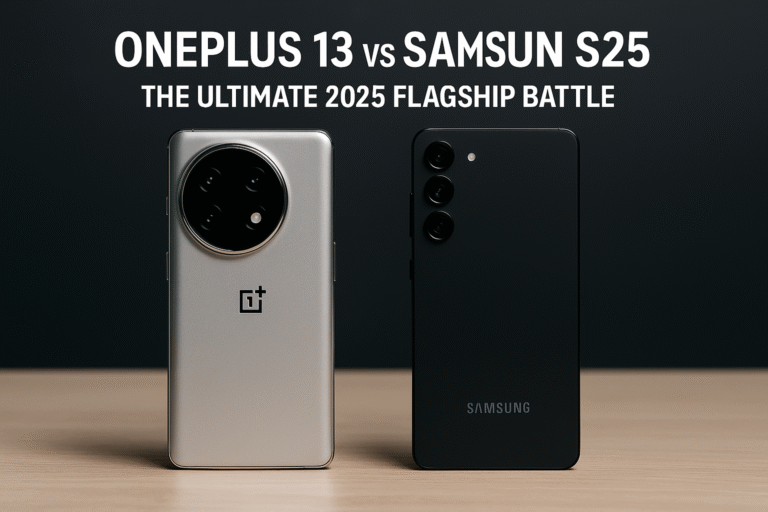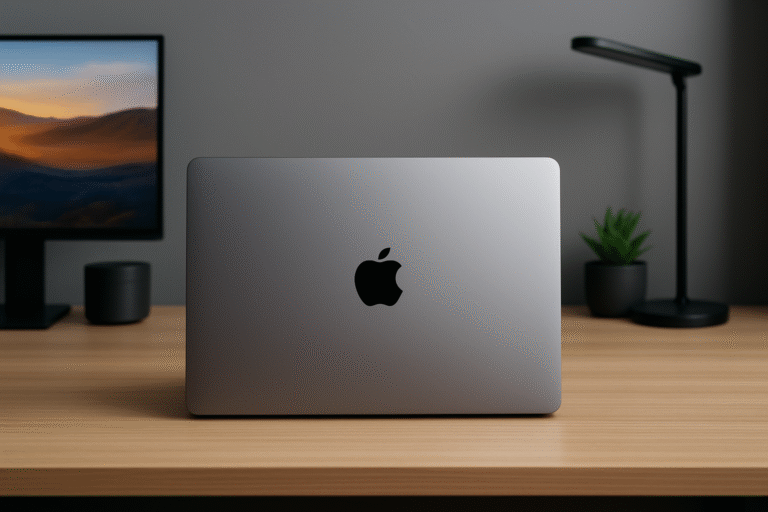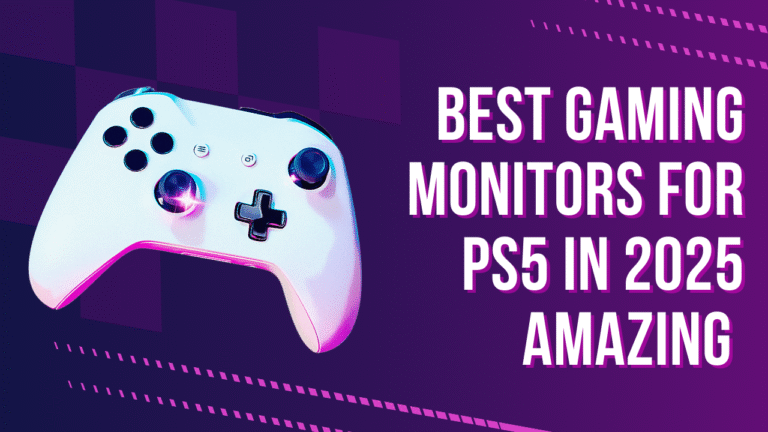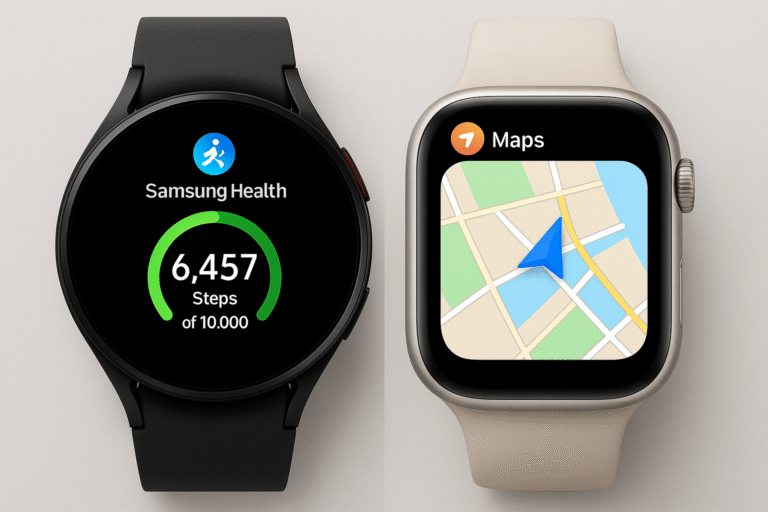iPad Pro vs Surface Pro: Shocking Differences You Need to Know! 2025
The iPad Pro and Surface Pro are two of the most powerful and versatile tablets on the market today, each targeting professionals, students, and creatives. Both offer laptop-like performance, support for stylus input, and detachable keyboards, but they do so in very different ways. The key distinction lies in their operating systems—Apple’s iPadOS vs Microsoft’s Windows 11—which defines their core functionality and workflow capabilities.
The iPad Pro excels in content creation, portability, and ecosystem synergy. It’s favored by designers, video editors, and users already integrated into the Apple ecosystem. The Surface Pro, on the other hand, is a full-fledged Windows PC in tablet form. It’s perfect for users needing desktop software like Adobe Photoshop, Microsoft Office with full functionality, or custom enterprise apps.
Choosing between them depends on your needs: Are you looking for a sleek, powerful tablet with best-in-class display and app responsiveness? Or do you need a compact machine that runs full Windows software? By examining categories such as design, performance, battery life, and accessories, we’ll help you decide which device is best for you.
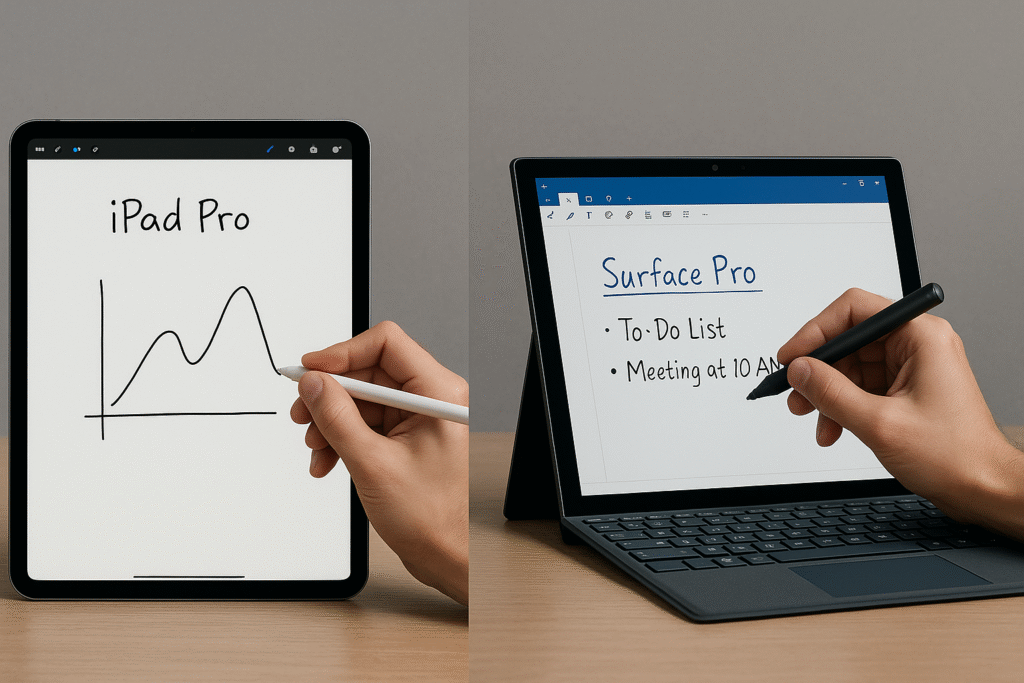
Design and Build Quality Comparison
Apple and Microsoft both bring premium design to their tablet lineups. The iPad Pro features a sleek, minimalist aluminum unibody with flat edges, available in 11-inch and 12.9-inch models. It feels incredibly slim and light in hand, especially considering its performance power. The Surface Pro adopts a more utilitarian design with a built-in kickstand and detachable keyboard. It feels slightly thicker and heavier but offers better angle adjustability and a more laptop-like setup.
While the iPad Pro focuses on symmetry and elegance, the Surface Pro’s design is about practicality. Its built-in kickstand supports various usage positions, whether you’re typing, sketching, or streaming media. The iPad Pro relies on third-party cases or stands for similar flexibility, which can be less convenient.
On the other hand, the Surface Pro is designed for a more practical, utilitarian experience. Its built-in kickstand is a game-changer, allowing you to adjust the angle of the screen to suit your needs, making it more versatile than the iPad Pro when it comes to positioning. The Surface Pro’s more extensive port selection—USB-A, USB-C, and microSD—sets it apart for users who need a range of connectivity options. While the iPad Pro’s single USB-C port offers faster data transfer speeds, it often requires dongles for certain connections. Depending on your use case, the iPad Pro might be more aesthetically pleasing, while the Surface Pro offers better functionality for those requiring multiple connection options.
In terms of ports, the Surface Pro includes USB-A, USB-C, and a microSD card slot—great for expandability. The iPad Pro uses a single USB-C or Thunderbolt port depending on the model, which may require dongles for accessories.
Both are exceptionally well-built, but your preference may come down to aesthetics versus functional design.
Display Technology: Liquid Retina vs PixelSense
The display is one of the most critical aspects of a tablet experience, and both Apple and Microsoft shine here. The iPad Pro features a Liquid Retina display with ProMotion technology, offering a 120Hz refresh rate and excellent color accuracy. The 12.9-inch model uses mini-LED technology, delivering deep blacks and high brightness—ideal for HDR content.
On the other hand, the Surface Pro features a PixelSense display that’s crisp, vibrant, and color-accurate. While it doesn’t use mini-LED, it still offers excellent sharpness and brightness. Most models support a 120Hz refresh rate now as well, making them competitive with Apple’s offering.
Both screens support stylus input (Apple Pencil and Surface Pen) and provide responsive and low-latency experiences. For creatives and professionals working with visual media, the iPad’s display slightly edges ahead due to its higher contrast ratio and color fidelity, especially on the 12.9-inch version.
The Surface Pro, while equally impressive, features a PixelSense display that provides excellent resolution, brightness, and color accuracy. The screen is sharp and vibrant but does not use mini-LED, so the contrast and depth of black may not be as rich as the iPad Pro’s. However, the PixelSense display does support a 120Hz refresh rate, bringing it in line with the iPad Pro in terms of smooth visuals. For professional graphic designers, photographers, and videographers, the iPad Pro’s display has an edge, especially when it comes to handling fine detail and color accuracy.
Performance and Speed: Apple M-Series vs Intel/ARM Chips
Performance is where the iPad Pro truly impresses. Powered by Apple’s M2 chip, the iPad Pro delivers exceptional speed and efficiency—handling demanding apps like Final Cut Pro, LumaFusion, and Procreate with ease. Multitasking is smooth, and the device remains cool under pressure.
The Surface Pro lineup varies depending on configuration. The latest models offer Intel Core Ultra processors or ARM-based Snapdragon chips. While Intel chips offer better legacy app compatibility and strong multitasking, they aren’t as energy efficient or consistently fast as Apple’s silicon. ARM versions improve battery life but may face software compatibility issues.
In real-world usage, the iPad Pro feels more responsive thanks to optimized hardware-software integration. However, users needing x86 application support or heavy multitasking might lean toward the Surface Pro.
The Surface Pro, however, comes in a range of configurations, with Intel Core processors or ARM-based chips, depending on the model. The Intel-powered Surface Pro excels in running legacy Windows applications and handling multi-threaded tasks, but it is not as energy-efficient as the M2 chip. ARM-based models offer better battery life but may face compatibility issues with certain legacy software. While the Surface Pro is more versatile in terms of operating system compatibility, the iPad Pro’s performance remains more consistent due to Apple’s tight hardware-software integration.
Operating System: iPadOS vs Windows 11
The operating system defines how you interact with your device. iPadOS is streamlined, intuitive, and optimized for touch and stylus input. It offers a fluid user experience and excels at apps like Procreate, LumaFusion, and other creative tools. However, it’s still limited compared to desktop-class OSes in areas like file management, external display support, and multitasking.
Windows 11, on the other hand, is a full desktop OS. It runs traditional software and supports advanced multitasking, virtual desktops, and extensive peripheral support. You can use the Surface Pro just like any laptop, which is ideal for power users and those in enterprise environments.
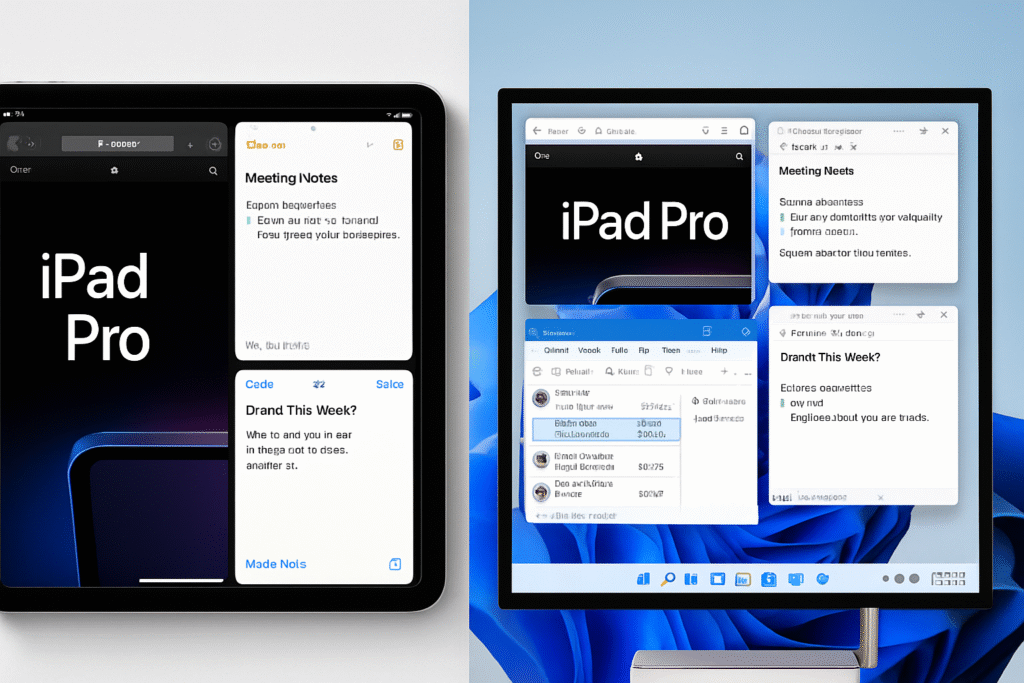
Productivity and Multitasking Capabilities
Multitasking is an area where these devices diverge sharply. iPadOS has improved in recent years, introducing Stage Manager and Split View, but it still can’t match the flexibility of a true desktop environment. You can have multiple windows open, but managing them can feel clunky compared to a laptop.
The Surface Pro, running Windows 11, supports true multitasking with resizable windows, window snapping, and full desktop productivity apps. For tasks like managing spreadsheets, using multiple apps side by side, or running virtual desktops, Surface Pro provides a better experience.
Accessories: Apple Pencil vs Surface Pen and Keyboards
Accessories play a big role in how you interact with your device. The Apple Pencil (2nd Gen) magnetically attaches to the iPad Pro and offers industry-leading latency, pressure sensitivity, and tilt recognition—ideal for artists and note-takers. The Magic Keyboard transforms the iPad into a mini laptop with backlit keys and a responsive trackpad.
The Surface Pen also offers great performance, though some artists find the Apple Pencil slightly more precise. The Surface Type Cover is lighter and thinner than the Magic Keyboard, with a decent typing experience and trackpad, but it lacks the premium feel of Apple’s offering.
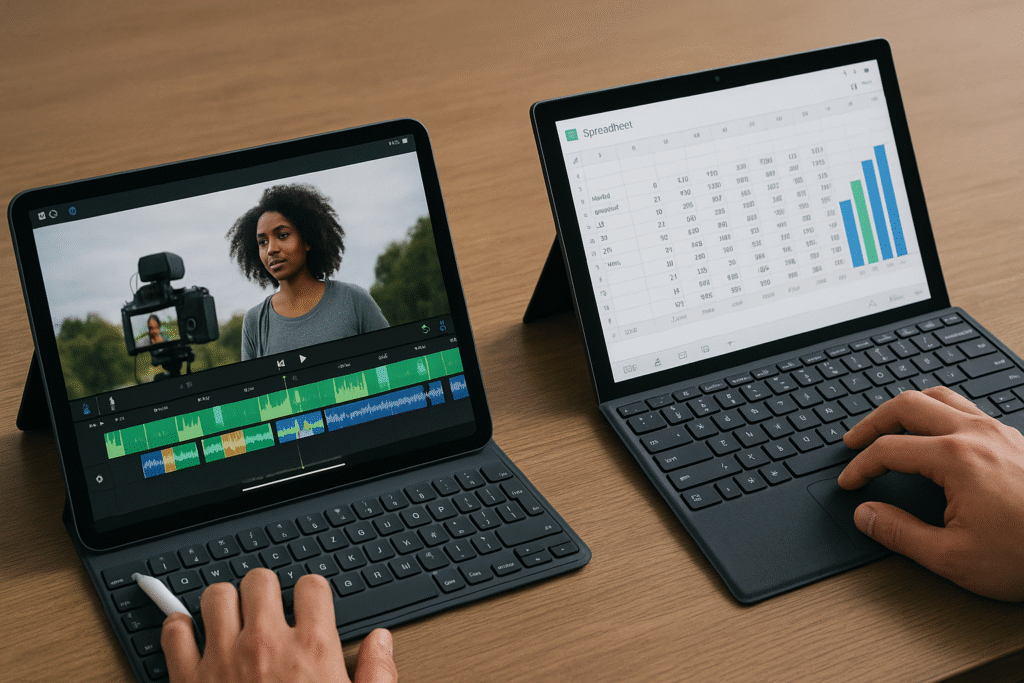
App Ecosystem and Software Compatibility
Apple’s App Store is filled with touch-optimized apps, many exclusive to iPadOS. From Procreate to LumaFusion, iPad Pro excels in creative and educational apps. However, it can’t run full desktop applications like Xcode, AutoCAD, or legacy enterprise apps.
The Surface Pro’s key advantage is its compatibility with Windows desktop software. If you rely on full versions of Excel, Photoshop, or any legacy programs, the Surface is the way to go. You also get broader browser compatibility and better file system access.
Battery Life and Charging
Battery life is essential for mobile productivity. The iPad Pro delivers around 10 hours of mixed use, with excellent standby time and fast charging via USB-C or Thunderbolt. Its power efficiency is a major plus of the M2 chip.
Surface Pro battery life varies by model. ARM-based Surface Pros tend to last longer—up to 13 hours—while Intel versions average around 8–10 hours. However, Windows is generally less efficient than iPadOS in terms of power usage.
Pricing and Configurations
The iPad Pro starts at a higher base price, especially when you add the Apple Pencil and Magic Keyboard. Models begin around $799 for 11-inch and $1,099 for 12.9-inch, but a fully-loaded setup can approach $2,000.
The Surface Pro also starts around $999, but Microsoft frequently offers bundles with keyboard and pen. Prices vary widely depending on configuration—ARM or Intel, storage, and RAM options.
Which Is Better for Students?
Students need portability, good battery life, and reliable note-taking tools. The iPad Pro excels here—lightweight, long-lasting, and great for digital notes and sketching. Apps like Notability and GoodNotes make it a favorite among college students.
However, Surface Pro may be more suitable for students in technical or business majors who require full Windows apps or coding tools. Its keyboard is more laptop-like, and compatibility with academic software is broader.
Which Is Better for Professionals?
Professionals seeking high-performance tools will find value in both devices depending on their workflow. Creatives, designers, and video editors may favor the iPad Pro’s display, Apple Pencil, and optimized apps. Its integration with the Apple ecosystem is a huge plus.
On the other hand, professionals in IT, engineering, business, or finance may need the flexibility and software support of the Surface Pro. Windows 11’s file system, software ecosystem, and peripheral support make it better suited for enterprise environments.
Final Verdict: iPad Pro or Surface Pro?
There’s no one-size-fits-all answer. The iPad Pro is best for creatives, students, and anyone deeply embedded in the Apple ecosystem. It’s powerful, sleek, and fun to use. The Surface Pro is ideal for those who need full Windows software, deeper multitasking, or enterprise support.
Consider how you plan to use your tablet day-to-day. Are you creating, consuming, or managing complex workflows? That answer will guide your choice.
Frequently Asked Questions (FAQ)
Can the iPad Pro replace a laptop?
Yes, for many users—especially creatives and students—it can, especially with a keyboard.
Does the Surface Pro run full desktop apps?
Yes, it runs full Windows 11 desktop applications.
Which has better battery life?
The iPad Pro generally has better battery efficiency, though ARM-based Surface Pros compete well.
Is the Apple Pencil better than the Surface Pen?
They’re both excellent, but the Apple Pencil has slightly better precision and latency.
Which one is more affordable?
The Surface Pro offers more pricing flexibility. The iPad Pro has a higher upfront cost, especially with accessories.
Links and References
- Apple iPad Pro Official Page
- Microsoft Surface Pro Official Page
- Microsoft Surface Pen Page
- Top iPad Apps for Productivity – Macworld
if you need further explanation contact us
read more posts by blog page

